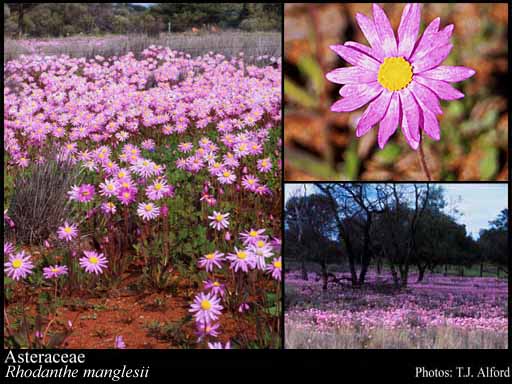- Reference
- Prir.Rostlin 254 (1820)
- Name Status
- Current







Scientific Description
Common name. Daisy Family.
Habit and leaf form. Herbs (mostly), or trees (rarely), or ‘arborescent’, or shrubs (rarely), or herbaceous climbers (rarely), or lianas (rarely); laticiferous, or non-laticiferous and without coloured juice; bearing essential oils, or without essential oils; resinous, or not resinous. ‘Normal’ plants, or switch-plants. Leaves well developed, or much reduced (sometimes). Plants non-succulent, or succulent (a few). Annual, biennial, and perennial; plants with a basal concentration of leaves, or with neither basal nor terminal concentrations of leaves. Self supporting (usually), or climbing (rarely); the climbers stem twiners, or scrambling. Mikania twining anticlockwise. Hydrophytic (very rarely, e.g. species of Bidens, Cotula), or helophytic, or mesophytic, or xerophytic; the hydrophytes rooted. Leaves of hydrophytes submerged and emergent; alternate (usually), or opposite (less often), or whorled (rarely); when alternate, spiral; ‘herbaceous’, or leathery, or fleshy, or membranous, or modified into spines; petiolate to sessile; sheathing, or non-sheathing. Leaf sheaths when present, with free margins. Leaves gland-dotted, or not gland-dotted; aromatic, or foetid, or without marked odour; simple (usually, unambiguously), or compound; peltate (occasionally), or not peltate; epulvinate. Leaf blades dissected, or entire; when dissected, pinnatifid, or palmately lobed, or runcinate, or much-divided, or spinose. Leaves without stipules (nearly always), or with stipules (rarely). Leaf blade margins entire, or crenate, or serrate, or dentate; prickly, or not prickly; flat, or revolute, or involute. Leaves without a persistent basal meristem; when compound, becoming compound from primordial lobes. Domatia recorded (only from a Vernonia species); represented by pits. Leaf anatomy. Hydathodes present (occasionally), or absent. Stem anatomy. Nodes unilacunar, or tri-lacunar, or multilacunar. Secondary thickening absent, or developing from a conventional cambial ring, or anomalous; when anomalous, via concentric cambia, or from a single cambial ring.
Reproductive type, pollination. Fertile flowers hermaphrodite, or functionally male, or functionally female. Unisexual flowers present, or absent. Plants gynomonoecious (commonly, with hermaphrodite disk florets and female ray florets), or hermaphrodite, or monoecious, or dioecious, or androdioecious (rarely), or gynodioecious (rarely), or polygamomonoecious. Entomophilous (mostly), or anemophilous (in the Anthemideae, which include significant hayfever plants). Pollination mechanism conspicuously specialized (with active pollen presentation involving stylar and staminal filament modifications, and the Cynareae also with irritable stamens), or unspecialized (in anemophilous forms).
Inflorescence and flower features. Flowers aggregated in ‘inflorescences’; in heads. The terminal inflorescence unit racemose (but the primary capitula sometimes in cymose secondary heads). Inflorescences nearly always indeterminate heads, but sometimes primary ‘heads’ reduced to single florets are grouped into secondary heads — e.g. Echinops; with involucral bracts; usually more or less pseudanthial. Flowers bracteate (the bracts forming an involucre in one to several series); minute to small; regular, or regular and somewhat irregular, or regular and very irregular (often combining central actinomorphic and marginal ‘ray’ florets); (4–)5 merous; cyclic; tricyclic, or tetracyclic. Perianth with distinct calyx and corolla, or petaline (the calyx sometimes absent — e.g. Ambrosia and relatives, and usually much modified or scarcely recognisable as such); (1–)3–35; 1 -whorled, or 2 -whorled. Calyx present, or vestigial, or absent; when present, (1–)2–30 (of scales, awns or bristles constituting the ‘pappus’); represented by bristles (commonly), or not represented by bristles; 1 -whorled; open in bud; persistent, or not persistent; often accrescent (becoming the pappus), or non-accrescent. Corolla present; 1–3 (ligulate florets), or (4–)5 (disk florets); 1 -whorled; gamopetalous; valvate; campanulate, or funnel-shaped, or tubular, or ligulate (i.e. with campanulate to tubular disk and ligulate ray florets, with campanulate to tubular florets only, or (in Cichorieae) ligulate florets only); unequal but not bilabiate (ligulate), or regular, or unequal but not bilabiate and regular (in the one flower), or bilabiate (in Mutisieae). Fertile stamens present, or absent (when female or sterile). Androecium 3–5. Androecial members adnate; coherent; 1 -whorled. Stamens 3–5; oppositisepalous (or rather, inserted on the corolla tube, alternating with the lobes); filantherous (with short filaments). Anthers cohering (nearly always, forming a tube around the style — with a few exceptions among anemophilous Anthemideae); basifixed; dehiscing via longitudinal slits; tetrasporangiate (usually), or bisporangiate (occasionally); usually appendaged. The anther appendages apical, or apical and basal. Fertile gynoecium present, or absent (in male and sterile florets). Gynoecium 2 carpelled. The pistil 1 celled. Gynoecium syncarpous; synovarious to synstylovarious; inferior. Ovary unilocular; 1 locular. Gynoecium median. Epigynous disk usually present (around the base of the style). Styles 2; partially joined; attenuate from the ovary. Stigmas 2; dry type; papillate; Group II type. Placentation basal. Ovules in the single cavity 1; ascending; non-arillate; anatropous.
Fruit and seed features. Fruit non-fleshy; indehiscent; a cypsella (almost invariably), or a drupe (occasionally). Dispersal unit the fruit. Dispersal commonly by wind via the hairy pappus. Seeds non-endospermic (or endosperm ‘very thin’). Cotyledons 2 (expanded). Embryo achlorophyllous (17/21); straight (oily). Seedling. Germination phanerocotylar.
Physiology, biochemistry. Aluminium accumulation not found (but many accumulate selenium). Photosynthetic pathway: C3, or C4, or CAM, or C3-C4 intermediate.
Geography, cytology, number of species. World distribution: cosmopolitan. X = 2–19(+). 13000 species.
Economic uses, etc. Sources of foodstuffs include Lactuca (lettuce), Cynara (globe artichoke), Cichorium (chicory and endive), Tragopogon (salsify). Insecticides from Pyrethrum, safflower dye from Carthamus. At least 200 genera are widely planted as ornamentals; and some are notorious hayfever plants (‘ragweed’ (Ambrosia), etc.).